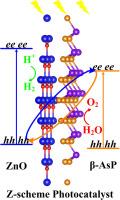直接z型ZnO/β-AsP异质结构对水裂解光催化性能增强的第一性原理研究
IF 6.3
2区 材料科学
Q2 CHEMISTRY, PHYSICAL
引用次数: 0
摘要
直接z型异质结构催化剂是光催化水裂解制氢的理想催化剂。在这项工作中,理论上提出了直接Z-scheme ZnO/β-AsP异质结构,并利用第一性原理方法研究了其光催化性能。ZnO/β-AsP异质结构中减小带隙、改善光吸收、增强载流子迁移率和降低激子结合能的协同效应是其优越光电性能的重要原因。ZnO/β-AsP异质结构的强内置电场有利于光激发载流子的空间分离,而其能带边缘横跨水的氧化还原电位。光激发载流子的转移遵循z方案途径,实现有效的载流子分离和强大的氧化还原能力。此外,拉伸应变工程显著优化了ZnO/β-AsP异质结构的电子结构,增强了光吸收,实现了整体水分解的热力学可行性。本理论研究突出了ZnO/β-AsP异质结构作为太阳能驱动水分解直接z型催化剂的前景,为设计高性能直接z型光催化剂提供了有价值的理论指导。本文章由计算机程序翻译,如有差异,请以英文原文为准。

First-principles perspective on the enhanced photocatalytic performance of the direct Z-scheme ZnO/β-AsP heterostructure for water splitting
Direct Z-scheme heterostructure-based catalysts are highly desirable for hydrogen generation through photocatalytic water splitting. In this work, a direct Z-scheme ZnO/β-AsP heterostructure is theoretically proposed, and its photocatalytic performance is investigated using the first-principles method. The synergistic effects of reduced bandgap, improved light absorption, enhanced carrier mobility, and lowered exciton binding energy in ZnO/β-AsP heterostructure contribute to its superior optoelectronic properties. The strong built-in electric field of ZnO/β-AsP heterostructure facilitates the spatial separation of photoexcited carriers, while its band edges straddle the redox potentials of water. The transfer of photoexcited carriers follows a Z-scheme pathway, enabling efficient carrier separation and robust redox capability. Furthermore, tensile strain engineering significantly optimizes the electronic structure of ZnO/β-AsP heterostructure, boosts light absorption, and fulfills the thermodynamic feasibility of overall water splitting. This theoretical study highlights ZnO/β-AsP heterostructure as a promising direct Z-scheme catalyst for solar-driven water splitting, providing valuable theoretical guidance for the design of high-performance direct Z-scheme photocatalysts.
求助全文
通过发布文献求助,成功后即可免费获取论文全文。
去求助
来源期刊

Surfaces and Interfaces
Chemistry-General Chemistry
CiteScore
8.50
自引率
6.50%
发文量
753
审稿时长
35 days
期刊介绍:
The aim of the journal is to provide a respectful outlet for ''sound science'' papers in all research areas on surfaces and interfaces. We define sound science papers as papers that describe new and well-executed research, but that do not necessarily provide brand new insights or are merely a description of research results.
Surfaces and Interfaces publishes research papers in all fields of surface science which may not always find the right home on first submission to our Elsevier sister journals (Applied Surface, Surface and Coatings Technology, Thin Solid Films)
 求助内容:
求助内容: 应助结果提醒方式:
应助结果提醒方式:


